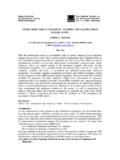Transcription of ULTRASONOGRAPHY OF THE THYROID
1 1 ULTRASONOGRAPHY OF THE THYROID Manfred Blum, , Professor of Medicine and Radiology, New York University School of Medicine New York, NY 10016. Updated April 6, 2020 ABSTRACT THYROID ULTRASONOGRAPHY (US) is the most common, extremely useful, safe, and cost-effective way to image the THYROID gland and its pathology. US has largely replaced the need for THYROID scintigraphy except to detect iodine-avid THYROID metastases after thyroidectomy and to identify hyper-functioning (toxic) THYROID nodules.
2 This chapter reviews the literature; discusses the science and method of performing US; examines it s clinical utility to assess THYROID goiters, nodules, cancers, post-operative remnants, cervical lymph nodes, and metastases; presents it s practical value to enhance US-guided aspiration biopsy of THYROID lesions (FNA); and endorses it s importance in medical education. US reveals, with good sensitivity but only fair specificity very important and diagnostically useful clues to the clinician and surgeon about the likelihood that a THYROID nodule is malignant.
3 Color flow Doppler enhancement of the US images, that delineates the vasculature, is essential. Comprehensive understanding of the local anatomy, the specific disease process, technical skill and experience are essential for proper interpretation of the US images. Features that favor the presence of a malignant nodule include decreased echogenicity, microcalcifications, central hypervascularity, irregular margins, an incomplete halo, a tall rather than wide shape (larger in the anteroposterior axis compared to the horizontal axis, the nodule is growing in one direction and not growing concentrically), documented enlargement of the solid portion of the nodule and associated lymphadenopathy.
4 Several of these attributes enhance the diagnostic probability. The patient s history, physical examination, and comorbidities refine the diagnosis. FNA and cytological examination of THYROID nodules and adenopathy in adults, children, and adolescents has become a major, specific, and highly diagnostic tool that is safe and inexpensive. In addition, the aspirate may be analyzed by biochemical measurements and especially by evolving molecular genetic methods. INTRODUCTION ULTRASONOGRAPHY (US) is the most common and most useful way to image the THYROID gland and its pathology, as recognized in guidelines for managing THYROID disorders published by the American THYROID Association (1) and other authoritative bodies.
5 In addition to facilitating the diagnosis of clinically apparent nodules, the widespread use of US has resulted in uncovering a multitude of clinically imperceptible THYROID nodules, the overwhelming majority of which are benign. The high sensitivity for nodules but inadequate specificity for cancer has posed a management and economic problem. This chapter will address the method and utility of clinically effective THYROID US to assess the likelihood of cancer, to enhance fine needle aspiration biopsy and cytology (FNA), to facilitate other THYROID diagnoses, and to teach thyroidology.
6 Previously, imaging of the THYROID required scintiscanning to provide a map of those areas of the THYROID that accumulate and process radioactive iodine or other nucleotides. The major premise of THYROID scanning was that THYROID cancers concentrate less radioactive iodine than healthy tissue and therefore provided triage in the selection for THYROID surgery. Unfortunately, however, since benign nodules also concentrate radioactive iodine poorly, the selection process is too inefficient to be cost-effective.
7 Although, scintiscanning remains of primary importance in patients who are hyperthyroid or for detection of iodine-avid tissue after thyroidectomy for THYROID cancer, US has largely 2 replaced nuclear scanning for the majority of patients because of its higher resolution, superior correlation of true THYROID dimensions with the image, smaller expense, greater simplicity, and lack of need for radioisotope administration. The other imaging methods, computerized tomography (CT), magnetic resonance imaging (MRI), and 18F-FDG positron emission tomography (PET) are more costly than US, are not as efficient in detecting small lesions, and are best used selectively when US is inadequate to elucidate a clinical problem (2,3).
8 As with any test, US should be used to refine a differential diagnosis only when it is needed to answer a specific diagnostic question that has been raised by the clinical history and physical examination (4). Its use as a screening tool for THYROID nodules and lesions such as Hashimoto s disease is debatable. The US image must be integrated into patient management and correlated precisely with the other data. A technique has been reported that helps the clinician to interpret THYROID scintigrams of goiters and non-functioning nodules by assembling scintiscans and US side-by-side as one composite image (2).
9 As an example of the utility of this protocol, sometimes it is difficult to correlate an ultrasound image and a scintigram. For instance, in a goiter, a small cold region may not be distinctive on the US examination. Thus, it may be unclear exactly where to insert a biopsy needle to obtain cytology of the nodule (that could be neoplastic) rather than sampling the rest of the goiter (that usually is benign). In such cases, it is useful to display the two different kinds of images side-by-side or superimposed.
10 Medical testing must be cost-effective. There is documentation that in a hospital or emergency department setting, the expense of THYROID ultrasound is quite low (5). Although sonography can supply very important and clinically useful clues about the nature of a THYROID lesion, it does not reliably differentiate benign lesions and cancer. However, it can help significantly. US can: 1. Depict accurately the anatomy of the neck in the THYROID region, 2. Help the student and clinician to learn THYROID palpation, 3.


